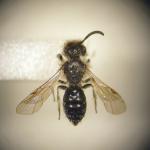This bee is one of eleven British species in the subgenus Micrandrena. These are very small species (body length 5–7 mm) that have an entirely black body integument relieved only by feeble transverse lateral bands of silvery hairs on tergites 2–4. Several species present difficult challenges to identification, as this often requires an appreciation of very subtle differences in surface microsculpture on the metasomal tergites and puncture density on the mesonotum. More pictures and notes here
Southern England and East Anglia. Also recorded from the Channel Islands. It is rarely common in any one site and females are far more often encountered than males. The summer brood is generally more often seen than the spring brood. The bee is almost certainly under-recorded (for example, recent visits to chalk grasslands often produced the species in numbers) and, on account of its small size, is easily overlooked.
In mainland Europe the species occurs from southern Sweden to southern Iberia, east to Turkey (Stöckhert, 1933; Gusenleitner & Schwarz, 2002). It has also been recorded from North Africa (Morocco) (Warncke, 1981).
The species is listed as Rare (RDB3) by Shirt (1987) and Falk (1991). However, the species is not regarded as threatened.
Dry, well drained soils, particularly chalk grassland, occasionally heaths, dunes, commons and cliffs both coastal and inland.
Bivoltine. The spring brood flies from late April to early June, the summer one from July to early September. There are slight morphological differences between both sexes between the spring and autumn generations. Perkins (1914) described each of these as a distinct species: Andrena moricella (spring) and alfkenella (summer). Later (Perkins, 1919) he realised that they belonged to just a single species, alfkenella, the name moricella becoming a junior synonym of alfkenella.
Little known. In mainland Europe the species has been reported to nest in moderately sloping sand and loam banks (Kocourek, 1966).
Spring brood: a cabbage, a cinquefoil, blackthorn, a speedwell, a knapweed, a cat’s-ear, daisy, a mayweed. Summer brood: wild angelica, wild parsnip, hogweed, upright hedge-parsley, wild carrot.
An unidentified Stylops (Strepsiptera) species has been found affecting a few females of this bee in south Devon (Spooner in Stidston, 1951).
2016


